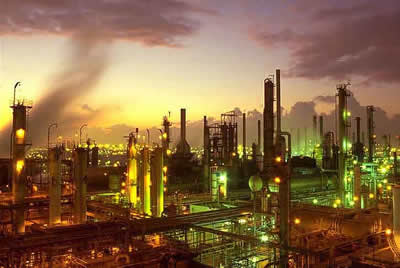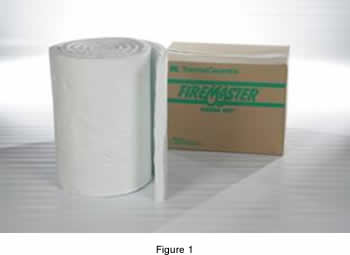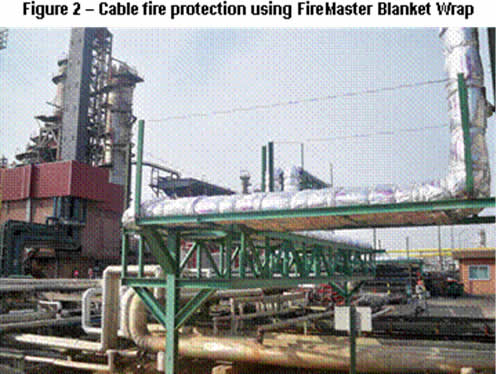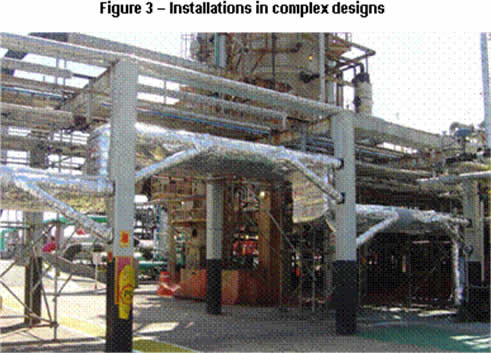Fire Protection: Cable Trays in Oil and Chem Refineries
Fire Protection: Cable Trays in Oil and Chem Refineries
 One of the most significant fire protection requirements for refineries and other offshore locations is the need to protect control cables and control valves from the possibility of a fire. Several options are on the market, including fire blanket systems, calcium silicate board, and flexible mats that absorb heat in the event of a fire. The available cable fire protection solutions all offer unique benefits, and refinery operators need to weigh the pros and cons of each to ensure that they select what is best for a particular application.
One of the most significant fire protection requirements for refineries and other offshore locations is the need to protect control cables and control valves from the possibility of a fire. Several options are on the market, including fire blanket systems, calcium silicate board, and flexible mats that absorb heat in the event of a fire. The available cable fire protection solutions all offer unique benefits, and refinery operators need to weigh the pros and cons of each to ensure that they select what is best for a particular application.
Protection by Separation
American Petroleum Industry (API) 2218, “Fireproofing Practices in Petroleum and Petrochemical Processing Plants,” provides guidelines for “selecting, applying, and maintaining fire-proofing materials that are designed to limit the extent of fire-related property loss in the petroleum and petrochemical industries.” Separating refinery operations into fire zones that can be isolated and safely shut down is a key objective so if a fire breaks out, the flow of the product being refined doesn’t feed the fire.
The API 2218 guidelines include a variety of protective measures, including fireproofing to improve the capacity of equipment and its support structure to maintain structural integrity during a fire. Shielding essential operating systems when they are exposed to fire is another important measure.
To protect the refinery and its components, the standard requires control valves that turn off the flow in the event of a fire, along with control cables that signal when to shut off the fuel. Under the API standards, the control valve and cable must be able to withstand a fire, usually for 20 minutes, but in some circumstances for 30 minutes or more. Examples of cable tray systems designed to protect the cables from fire include:
- Vendor-certified fireproofed cable tray systems
- Standard cable trays completely enclosed with insulating, fire-resistant fiber mats, or endothermic mats
- Cable trays encased with calcium silicate insulating panels with calcium silicate sleepers to hold cables away from bottom of the cable tray
- Trays with exterior surfaces made of galvanized sheet metal coated with mastic orintumescent fireproofing material
The material used to provide 30-minute fire protection against a hydrocarbon pool fire for grouped electrical cables inside conduit or a cable tray must be tested before installation, using the ASTM E 1725-95 method (Standard Test Methods for Fire Tests of Fire-Resistive Barrier Systems for Electrical System Components). The method is based on a model of the type of fire that could happen at a refinery: One that gets to 1500°F at three minutes, and between 1850°F and 2150°F after five minutes. Testing is carried out in accordance with hydrocarbon pool fire temperature-curve conditions outlined in ASTM E 1529 (50,000 +/-2,500 BTU/ft2hr).
The test is run at positive pressure over at least half the test assembly. Thermocouples are arranged in sets, with thermocouples peened every six inches on both rails of the cable tray, and every six inches on a bare copper wire centered in the tray. The cable tray is intended to run empty of cables, which provides approval for zero to 100% cable loading. Failure is determined when one “set” reaches an average temperature rise of 250°F or any single thermocouple reaches a temperature rise of 325°F.
Options for Meeting Fire Protection Standards
A wide range of options is available to protect control valves and grouped electrical cables against extended exposure to fire and maintain control of equipment operated by the cables.
One option involves wrapping cable trays and conduits with a nonflammable high temperature-resistant insulating blanket. The fire exposure period is rated in proportion to the wrap thickness and the material is typically weatherproofed in the field.
For example, FireMaster 607 Blanket (Figure 1) is a flexible blanket composed of high temperature fibers classified for applications to 2192°F. The core fibers are manufactured using the patented Superwool fiber technology, which uses a low bio-persistent insulating wool, reducing the risk for installers.

The blanket wrap system consists of a single layer of 2-inch, 8-pound-per-cubic-foot material and is designed for up to 12-inch cable trays and conduits. The lightweight flexible blanket wrap is easy to cut, reducing installation problems in complex designs. A simple wrap design allows easy re-entry for cable modifications. The insulation is supplied with full encapsulation in a glass fiber reinforced foil and polypropylene (FSP) facing as standard, to provide superior handling strength for installation. Optional weather and mechanical abuse protection may be added. The FireMaster fire protection system results in significant material cost and labor savings compared to composite products or rigid board installations. It is also lightweight, preventing the need for additional support structures and associated costs.


Another available option is calcium silicate board, an inorganic, non-combustible, high-temperature insulation. The material can offer some weather resistance and durability in many environments, but it can be heavy (around 54 pounds per cubic foot), which together with the cutting and fastening methods required, makes it relatively difficult to install. In addition, while the board itself is relatively inexpensive, the waste from cutting and the additional labor required for cutting and fastening makes it expensive to install. It is also less adaptive to complex cable tray runs.
A third option is an endothermic mat (e-mat), which protects structural steel, cable trays, and conduit circuits by chemically absorbing heat energy, blocking heat penetration. The product requires the installation of between three to five layers, resulting in increased weight and material costs – up to five to 10 times higher than insulation or board alternatives. These multilayer solutions also have additional labor costs. On the plus side, flexible mat solutions are not as insulating, so they can often be used to protect power cables, which generate heat. The other options discussed are more appropriate for use to protect control cables, which do not generate a significant amount of heat.
The intent of petroleum industry standards is to separate refinery fire zones by enough distance so that if a fire breaks out, it is possible to turn off the flow of chemicals, oil, or gas to the affected area so the fire does not feed itself. In that scenario, the cables and valves controlling the shut-off valves must be adequately protected. When selecting the most appropriate options to maintain control over these components, be sure to evaluate the total material costs, labor and installation costs, durability under the particular facility’s location, and any associated differences in long-term maintenance and replacement costs.[hr]
By Clay Booth, Fire Protection – Market & Sales Manager, Morgan Advanced Materials Thermal Ceramics Business
- Facts & Figures: Semiconductor Market Grew to a Record $336 Billion - March 2, 2015
- TLC and Metz Ethernet Cat 6A Patch Cords in Seven Vibrant Colors - January 27, 2014
- Cables Unlimited LC-LC Duplex Ruggedized Fiber Jumpers - January 27, 2014

